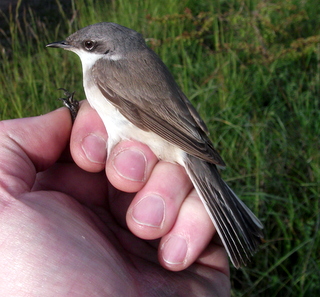SALISBURY PLAIN
On arrival we were greeted to just the one Nightingale singing which at the time was disappointing since this localised population is now down to only 2 singing males. We thought that perhaps he'd moved on in search of a mate elsewhere. Thankfully after a couple of net rounds we heard what we assumed was our bird giving the usual contact and alarm calls. While this was going on our male gave a brief burst of song from further back in the scrub. Hopefully this second bird is a female and the general silence of the male is because they are now a pair. Best of all our male was caught mid-morning and proved to be the same bird we always catch in this territory, a bird that we've caught every year since ringing it in 2010.

The session was pretty productive with over 140 birds caught although rather a large proportion of those were in the additional nets so don't count to the CES totals. Numbers included an impressive 16 Garden Warbler's and I can't remember the last time we caught 4 Lesser Whitethroat's in one spring session.
We also caught our first proper 3J passerine of the year in the form of a Blackbird.
On the way off of the Plain we made our usual attepmt at this time of year to catch some of the local Grasshopper Warbler's that can be found in the young scrub and bramble by the trackway since the 2 pairs in the CES area are absent this year. Usually we hear about 8-10 singing and catch around 5-6 of them so we were rather suprised not to hear a single bird. This last winter was particularly dry on their wintering grounds so this may have caused a drop in numbers. It will be interesting as the season moves on if this local decline is reflected nationally.
One side affect of wandering through the long grass in this area are the Tick's and this year its infested with them. After just 20 minutes I had to pick 26 off of my clothing. GD/PD/OF
62 new, 82 retraps
Blackbird 3(3), Song Thrush 4(2), Nightingale (1), Robin 2(5), Dunnock 5(8), Wren (4), Whitethroat 14(7), Lesser Whitethroat 3(1), Blackcap 5(15), Garden Warbler 4(12), Willow Warbler 1(6), Chiffchaff 2(8), Goldcrest 1(1), Long Tailed Tit (2), Blue Tit 1, Great Tit 1(3), Linnet 8, Bullfinch 2(1), Chaffinch 1(2), Goldfinch 1, Yellowhammer 4(1)
SWINDON STW

